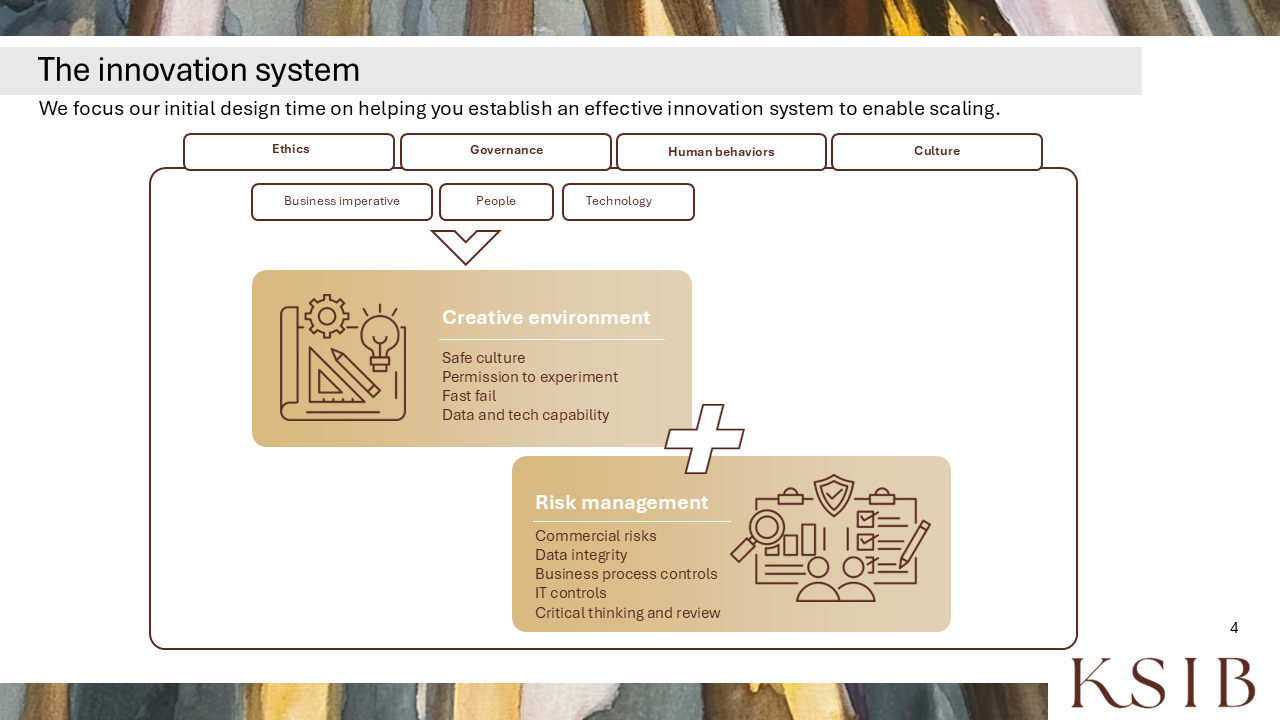Establishing an effective innovation system
August 12 2025
In our first article in our series “AI unleashed – safely optimising technology”, we reflected on the importance of taking the first leap forward in a measured and safe way. We argue that there is an opportunity for every Australian business to embrace technological change and the window to exploit this opportunity is open now. A bigger risk would be not to take the leap at all.
KSIB has developed and refined a seven-step methodology for taking that first leap. This approach is currently being used to help work through some major, complex agentic implementations at the largest end of our market. The methodology is outlined below and can be adapted for all sizes of organisation, whether you are implementing a massive operational transformation with a large data science and technology team, or whether you are a mid-sized company using off-the-shelf AI enhanced tools to change your business model or functions.
This article focuses on step number 2 in our methodology – implementing an innovation system.
Q: Why is this important?
A: Because collaboration is key to strategic innovation, but it needs to be organised in a system.
There has been extensive literature published in the scientific field about the impact and importance of collaboration impacts on research outcomes. A 2023 scientific paper published in Scientometrics 1 also analysed the importance of the role of the innovation system in facilitating collaboration, showing that collaborators working within highly evolved innovation systems have the most impact. We know that teamwork and collaboration has underpinned successful innovation ventures both within companies and across the economic landscape more broadly. Both Google and Apple were founded on collaborations (Larry Page and Sergey Brin; Steve Jobs and Steve Wozniak respectively) where complementary skills were used to drive the most iconic business collaborations of the 20th century. Those of us who have been around the business world for some time also know that successful change initiatives and transformations occur when collaboration is fostered and managed among team members. But this does not happen without a system.
Innovation systems should not follow a one-size-fits-all approach in our view. KSIB and its Associates have worked with hundreds of companies in a variety of industries across the world and we’ve seen many transformations and innovations, especially as companies adopt new technologies. Our view is that leadership is the key ingredient to success, including having the vision and understanding to create an innovation system that supports the enterprise and leverages the strengths of its culture. This system needs to be organised in a way that makes sense for the enterprise, its culture and ways of working. An organisation that has top-down decision making with standardised processes requires a different innovation system to an organisation with more federated, distributed decision making. Regardless of the structure, a system is always necessary to surface and execute innovative changes, however.
A bespoke innovation system that is relevant to your business supports collaboration, which has been shown time and time again to be critical to achieving innovation cut-through. The innovation system needs to create an environment that allows both creativity and risk management to thrive. This requires mobilising the right resources with diverse skillsets and ensuring that the environment supports all voices. The KSIB graphic below outlines how this might come together.
Establishing an innovation system to organise and foster collaboration at scale is critical to optimising technological change. This is especially important in the AI world, where agentic enterprise implementations offer disruptive opportunities for business models both at a revenue and productivity level. These opportunities are not only available to large companies with sophisticated data science and technology teams, but to mid-sized and smaller organisations whose leaders are prepared to understand and take advantage of new technologies. Putting the system together and then implementing the opportunities in a safe way is complex, however, and that is why we at KSIB are on a mission to try to cut through that complexity. Our Australian market stands to gain significantly if we can all embrace this opportunity while managing risks and thinking about our people. Our next article in this Safely Navigating AI series will focus on people and why critical thinking is a skill that needs to be further developed and fostered across organisations.
References:
1. Vieira, Elizabeth S. ‘The Influence of Research Collaboration on Citation Impact: The Countries in the European Innovation Scoreboard’. Scientometrics 128, no. 6 (2023): 3555–79. https://doi.org/10.1007/s11192-023-04715-4
To learn more about this topic, contact KSIB or email directly below
Kristin Stubbins, Founder and CEO
kristin@ksib.com.au







